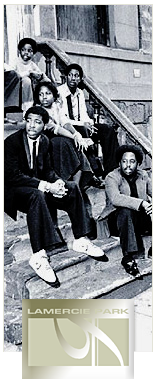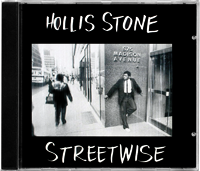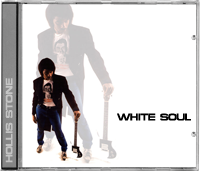
We're A Hit
Thirty-one years later, we're a hit. For reasons both inexplicable and
amusing, Streetwise, my first studio effort, somehow found its
way out of the living rooms of the perhaps two dozen people who
owned a copy and into dance clubs in Germany and France. I have
absolutely no idea how that happened, or how this little private
pressing has become a bona fide collector's item. What I can
tell you is I field nearly a dozen inquiries every week asking
if copies of the original vinyl release are available. So much
so that I've created a form letter response, telling the same
story of the extremely limited supply of sealed, shrink-wrapped
copies packed in boxes which were destroyed when my basement
flooded. The only copies I know to exist belong to the band
members themselves, at least two of whom--R&B producer Dinky
Bingham and The Voice house band vocalist Michael Hammond (who
was age eleven when we recorded this) --have gone on to
successful music careers. I myself own only one copy of the
original vinyl, and would happily purchase another from
collectors' resources if I could actually afford it. Prices have
thus far ranged from mid-three hundred to $1,429 per copy. And,
no, I don't get a royalty.
I find it enormously amusing and amazing all at once. The value
is surely in the scarcity of the vinyl first pressing and not in
the music itself. I sing a lot like a wounded moose and, with
the possible exception of the late brilliant funk bassist
William Wallace and the eleven-year old Michael (both praised in
correspondence sent to me and internet postings), the music is
of questionable value and the recording, on one-inch Scully
eight track, is iffy at best. I did spend real money on the
mastering from Bernie Grundman, whose company has mastered
countless classic LPs, and MasterDisc, one of America's
preeminent vinyl producers, created the master cylinder and
manufactured the discs.
Offering digital versions of the album would be iffy because the
only source files I have left are 292 kb ATRAC compressed
MiniDisc, and I omitted several tracks because they really were
just that bad. I suppose MasterDisc still has the
original master cylinder lying around somewhere and film for the
jacket, but, seriously, I can't imagine a second pressing of
this, a first effort by a group of high school kids.
For this 2000 compilation, sent to the original band members, I
used some alternate takes from the original Streetwise project,
stuff that exists now only on cassette and on the custom CDís
created for them, so
there really isnít any way to clean those tracks up. Also, Iíve
juggled the sequence of some things, looking to tell more of a
story than present a true anthology.
Love Letter #2 was never included on an official project, but
was kind of an afterthought. We had a little tape left on the
1982 White Soul album project, so I sat at the piano and warbled
my way through this little ditty, a musical note to Karen. I was
really uncomfortable playing and singing at the same time, but
this wasnít supposed to be polished and was really more of an
apology to her for spending so much time on the second album.
Iíve started the compilation with it because, looking over this
work, the core themes are my obsessions with women and God. The
cheery optimism of Love Letter #1 contrasts sharply against the
grim fatality of Chapter 4ís If I Should Perish (Love Letter
#4), this compilationís closing number, and I think they make
good bookends here.
The prayer invocation, Youíre The One, is our grace before
serving up the meal. Thereís some really fine Fender Rhodes here
by John Parker, who was constantly underrated, existing largely
in the shadow of Dinkyís pyrotechnics. I think we took this
live, with me standing in the drum booth while John played in
the studio.
1982ís Sorry To Say was, perhaps, the most successful piece of
studio music we did, Largely thanks to Dinky and John who
brought this Los Angeles smooth laid-back arrangement to an
otherwise forgettable amalgam of Shame and We Are Family. Dinky
hated his solo, a ripping 3-1/2 minute jazzy thing I copped off
of a Rolls Royce tune. I just didnít have the cash to let Dinky
go back and redo it, and, to my then-untrained ears, the solo
sounded fine. It still does, though I can see why heíd want
another shot at it.
We went in at about 10 PM to record Sorry..., and emerged about
7 AM. Yanick and Florence, the twins, worked at a cookie shop on
Queens Boulevard, and we headed over there for free cookies. I
was driving a rental car a friend rented for me because I didnít
have a driverís license. Neither did Dinky, who had been driving
for years without one (he was 15 or so when he started; I think
Dinky was about 17 or 18 at this time). Dinkyís example actually
inspired me to start driving without a license.
We had the tape with us, and we were so high, so very happy and
pleased. We were so young. The song came to represent this group
of friends, these talented young adults. It was the last
time we were all together at the same time.
New
Witness:
Original cover art shot
October 25, 1980, 7:30 AM:
Tyrone, Michael, Lester, Debra, Hollis, William Missing: Gene, John, Milton, Pearl, Derek.
Photo by Eliot R. Brown. Art was scrapped after Debra left the
group.
Frenemies
William Wallace, a pal from high school, holds a special place
in The Story. When I was 15 or so, William and I formed a group
called New Witness that eventually grew into a 8 or 9-piece band
with a 25 voice choir. All young adults, all spirit-filled and
gravely serious about doing Godís work, rehearsing in Williamís
basement under the spiritual guidance of his wonderfully
anointed mother Betty, whom I bless God for having brought into
all of our lives.
William, a gifted bass player, had control issues and insisted
on being in charge, the boss, head guy. I was the bandís
manager, saxophonist and lyricist, writing over Williamís tunes
(many of them very, very good, and William was only around 15
years old). Iím sure William always knew
heíd be a star. I certainly thought he would. He was my friend,
my family. We dreamed Big Dreams together.
William threw me out of New Witness over differences in
interpretation of scripture. I was a bit incredulous that
William, as Paul McCartney, would toss Lennon out on his ear
because he says to-MAY-to and John says to-MAH-to,
but that was
pretty much what happened. I was dismissed, and the band
dissolved a few months later.
 I really donít remember why I recruited William for the
Streetwise project, but I seem to recall it had something to do
with proving to him I held no hard feelings toward him. But
this was definitely my project, and William braced against
taking my direction. I ended up naming him co-producer or
something, but he wasnít nearly as available for those kinds of
tasks as the credit suggested.
I really donít remember why I recruited William for the
Streetwise project, but I seem to recall it had something to do
with proving to him I held no hard feelings toward him. But
this was definitely my project, and William braced against
taking my direction. I ended up naming him co-producer or
something, but he wasnít nearly as available for those kinds of
tasks as the credit suggested.
A decent person, fun to hang out with and a giving person
socially, William was what I would describe as a selfish
musician. Most musicians are selfish people, interested
primarily only in their own work and own projects. William
played his own tunes, like Mr. Ugly, very well, but played my
tunes with a kind of marginal enthusiasm. Mr. Ugly is William to
me, a pivotal figure in The Story, and a source of conflicting
feelings of loyalty and resentment.
Mr. Ugly also has a noise track over the music, where the band
stood around talking. This was a crude homage to Tom Brownís
Funkiní For Jamaica, but its role in this compilation is to
bring those people back to life. Those happy peopleó William,
Derek Burch, Milton, John (ďYeah, maybe I got old sneakers but
you canít play no ball, nigger!Ē), and at center stage, James
Crockett.
James wasnít in the band. He was my best friend and adopted
brother. He was trying to date Yanick in high school, and he was
the one who brought the twins into the project. James, like
Michael Hammondís ubiquitous bodyguard Dexter, became a kind of
hanger-on, only, here, on this tune, he became part of the band,
making the track sing simply by being himself.
 Dexter, by the way, was sent along with 11 year-old Michael to
make sure, I guess, that we werenít sickos out to exploit the
kid. But, after a few sessions, Michaelís mother knew we were
okay, and Dexter became more of a band mascot than Michaelís
bodyguard. I remember roaming Brooklyn in the after-hours with
the band, feeling perfectly safe because we had Dexter with us.
We were musicians, not tough guys. James was a tough guy. Dexter
was a tough guy. And, between Dexter and James, nobody was going
to get stupid with us. Weíd wander out at 2AM looking for food,
or take the subway over to the Village or whatever we wanted to
do. It was a really great time with really great friends.
Dexter, by the way, was sent along with 11 year-old Michael to
make sure, I guess, that we werenít sickos out to exploit the
kid. But, after a few sessions, Michaelís mother knew we were
okay, and Dexter became more of a band mascot than Michaelís
bodyguard. I remember roaming Brooklyn in the after-hours with
the band, feeling perfectly safe because we had Dexter with us.
We were musicians, not tough guys. James was a tough guy. Dexter
was a tough guy. And, between Dexter and James, nobody was going
to get stupid with us. Weíd wander out at 2AM looking for food,
or take the subway over to the Village or whatever we wanted to
do. It was a really great time with really great friends.
Daddy was a shot at my father, whom I have never met. When I was
10 years old, I used to sing a lot like young Michael Jackson,
so I recruited Michael Hammond, who sounded a lot like I did at
that age, to play my role in The Story, while I sang the part of
the grown-up me. I canít remember how I met Michael, except that
I had heard of him before I actually heard him, and was
introduced to his mother and worked things out with her before I
was formally introduced to this kid. Michael became a kind of
protťgť, which I now find a little laughable, considering I
didnít know what the heck I was doing.
Lester Liburd hated the drum pattern I wrote for the song. One
of my oldest friends in the world (we met at age 3 and our
friendship began on tricycles), Lester had a way of shooting me
this sarcastic, ďYouíve gotta be kidding me!?!Ē look. Iím so
used to hearing the pattern now, itís hard to remember his being
so up in arms about it.
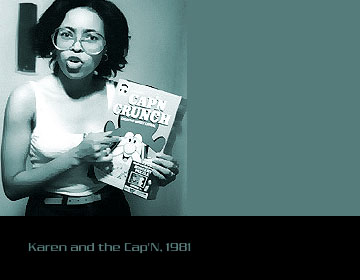 The Blessing was a song written for Karen, a girl I met when she
was 17 and living in Atlanta (long story). It had a bizarre key
shift on the chorus that kind of ruined it, I think, going from
A flat minor to B flat minor. Debra sang the song, but later
dropped out of the project under religious conviction against
secular music. The version that appeared on the album was a much
slicker mix with Pearl Bates performing the female lead. I
didnít include that version here because, with each consecutive
re-make of the song we lost more and more of its soul. Debraís
original lacks much subtlety, but the honest, rawer emotion is
much more beguiling, I think.
The Blessing was a song written for Karen, a girl I met when she
was 17 and living in Atlanta (long story). It had a bizarre key
shift on the chorus that kind of ruined it, I think, going from
A flat minor to B flat minor. Debra sang the song, but later
dropped out of the project under religious conviction against
secular music. The version that appeared on the album was a much
slicker mix with Pearl Bates performing the female lead. I
didnít include that version here because, with each consecutive
re-make of the song we lost more and more of its soul. Debraís
original lacks much subtlety, but the honest, rawer emotion is
much more beguiling, I think.
Prisoner of Madison Avenue was written for Karen. I was then and
am now a workaholic. I was also seriously enamored of this
cheery Billy Joel pop style (I think I had just gotten into
Allentown or Glass Houses) and was seriously into pop formula.
Dinkyís wonderful jazz riffs on Fender Rhodes were something I
could not fully appreciate than, but now I marvel at the then-15
year-old kid. I hated Tyroneís solo. He was a great guitar
player but he couldnít solo. Then again, neither could I.
Mansion In The Sand was my attempt to build a better vehicle for
Michael, who was great little trooper. I wanted something on
side 2 for Michael to shine on. I still like the song, in spite
of its minor fifth Hollywood Game Show chorus. I included the
version with the twins featured on backup because the harmonies
are stronger. Dinkyís organ dominates the track and we played
too fast, yielding a kind of runaway train experience.
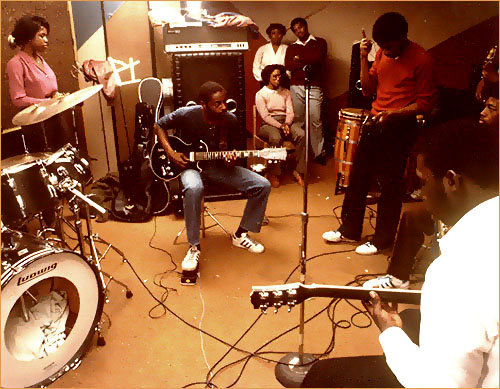
Inner City Sound:
October 1980: Debra, Tyrone, Pearl (seated) Hollis, Milton, Gene
Cropped: Lester (on drums), William (on Bass, far right). Photo by Eliot R. Brown
A New World
Elegy was something God inspired at some point during this
project. A somber and grown-up observational treatise on
Christians and Christianity, I liked it for its funereal pallor
and opted to play my own wretched piano for the raggedness of
it, rather than let a slick guy like John or a chops guy like
Dinky play it. Itís a truly morbid song that flaunts its wannabe
intellectual fakery at every bar, ending abruptly and
unfinished. Man, I thought I was something.
The Bridge was the one song I used from Williamís and my New
Witness Band. I really liked the song, and Williamís playing
here, as on Mr. Ugly, was superb, probably his best on the
album. I used an alternate take here, one with Debra and Michael
singing in a kind of cheery farewell chorus line. We lost this
version when we lost Debra (she asked we not use any of her
tracks on the album), but this is, to me, the superior
interpretation of Williamís song.
Just Friends was a vignette written to Karen. I think we broke
up or were about to break up, I canít remember. Thereís actually
a whole long-winded song behind that, but I wasnít interested in
recording it.
Journey came about during one of our endless jam sessions. I
just kept playing this little ditty Dinky put on the end of The
Blessing, and William improvised a surprisingly country western
riff over it. It was an unexpectedly Easy Listening bit of
business for this funky crew. I was nervous playing the piano
part, hoping people would not notice that it wasnít Dinky. I
also dubbed in the semi out-of-tune MiniMoog lead line. Iíve
included this reprise here as a kind of coda to the first
project as we transitioned, 9 months later, into a whole new
world.
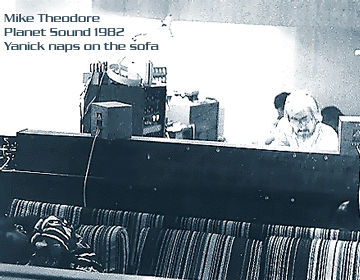 It was Mike Theordoreís world. Theodore had just taken over The
Daily Planet, a rehearsal studio on 30th Street in Manhattan we
rented from time to time, and upgraded it to Planet Studios, now
one of New Yorkís top studios. 24 tracks, huge rooms, grand
piano, Prophet V, and Mike worked a deal with me to buy blocks
of time at an unheard of $75 an hour. Our production values went
through the roof as we began the second album, White Soul, which
followed my vision of some amalgam of Gil Scott-Heron and
Prince.
It was Mike Theordoreís world. Theodore had just taken over The
Daily Planet, a rehearsal studio on 30th Street in Manhattan we
rented from time to time, and upgraded it to Planet Studios, now
one of New Yorkís top studios. 24 tracks, huge rooms, grand
piano, Prophet V, and Mike worked a deal with me to buy blocks
of time at an unheard of $75 an hour. Our production values went
through the roof as we began the second album, White Soul, which
followed my vision of some amalgam of Gil Scott-Heron and
Prince.
Have You Seen My Girl? was, oddly enough, inspired by Yanick.
Not in the sense of any true longing for her (we were completely
platonic in those days), but in the sense that Iíd been sent
searching for her once, and ended up wandering around down near
the pier trying to find her while she was trying to find a
bathroom or something. I wanted a bubblegum pop song for the
project, much like Prisoner of Madison Avenue. I was still
seriously into bubblegum, and I wanted the new album to have
some resonance with the old. Again, Dinky provided jazz riffs on
the break in the middle, playing over Derek Burchís bass. I
think, by now, William and I were kind of politely avoiding each
other, and I wanted to keep personnel to a minimum, going for
the severe Prince sound of those days. Derek pulled double duty
on bass and guitar.
The punk-inspired Join The CIA was just me being self-indulgent and riotously
cynical. I guess the song worked on some level, but I edited it
to just Michaelís parts here. Mike Theodore put a phase shifter
on Lesterís hi hat, giving it a metallic clanking sound, to give
the otherwise bald track a little something to run off of.
Same To Me was my first attempt to be Prince. Even as I recorded
it, I was humiliated by my laughable attempts at falsetto.
Eighteen
years later, it now sounds like a parody, almost a cool in-joke.
But I was very serious. I think I skipped that song every time I
played the demo. In fact, I think everyone did. I played drums
myself because I was looking for an edgy, amateurish strippy
sound, like Prince on Dirty Mind, and I knew if I asked Lester
for that he would give me The Look.
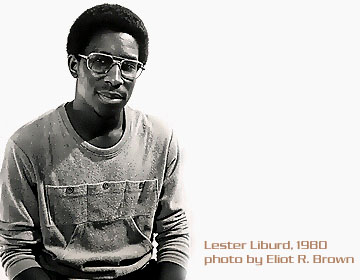 I also played drums on
White Boys for much the same reason. No
drummer I knew of could get it quite sucky enough. I also
recruited Larry Hama, my mentor in comics, and Danil Dreger, my
mentor of sorts in studio recording, to perform dueling
Stratocasters. This worked marginally well, but the two guys
didnít really gel, and I realized it probably would have been a
better idea to get Danilís bandmate to play with him, or get
Larryís bandmate to play with him; people they knew and could
easily mesh with. White Boys holds up pretty well, I think, as a
song designed to sound like a high school garage band.
I also played drums on
White Boys for much the same reason. No
drummer I knew of could get it quite sucky enough. I also
recruited Larry Hama, my mentor in comics, and Danil Dreger, my
mentor of sorts in studio recording, to perform dueling
Stratocasters. This worked marginally well, but the two guys
didnít really gel, and I realized it probably would have been a
better idea to get Danilís bandmate to play with him, or get
Larryís bandmate to play with him; people they knew and could
easily mesh with. White Boys holds up pretty well, I think, as a
song designed to sound like a high school garage band.
Drag Me Away came out of two specific influences: The
Temptationsí Masterpiece, which was producer Norman Whitfieldís
homage to himself (including a huge, messianic portrait of
himself on the albumís back cover) and a song that drones on for
nearly six minutes before any of the Temptations actually sing,
and B-Movie, Gil Scott-Heronís seminal work of biting social
commentary. Regrettably, I was no Gil Scott-Heron, and I
certainly was no Norman Whitfield. But Drag... dragged on for
more than ten minutes while I whined and complained.
One minor note: while mixing Sorry To Say and Drag Me Away, Mike
Theodore spent two full hours listening to Lesterís kick drum,
while I writhed on the sofa in the control room, counting up the
bills on the studioís still-running meter. When I asked him what
on Earth he was doing, Mike looked at me and said, ďAnything
worth doing is worth doing right.Ē And he was right. No point at
all in spending twenty-five hundred dollars and ending up with a
crummy tape.
Mike did a superb job and had lots of patience with me, someone
who had not much clue what he was doing, and who spent a fortune
recording songs no one wants to listen to.
Christopher J. Priest
January 2000 UPDATED OCTOBER 2013
Home | Blog | Projects | Comics | Rants | Music | Video | Christian Site | Contact
Unless otherwise specified, Copyright © 2013 Lamercie Park. All Rights Reserved.
TOP OF PAGE



